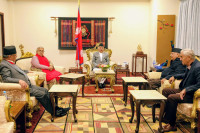Opinion
The big fish in our midst
Restaurant owner Anand Dahal of Chandranigahapur made news on these pages last month. Tired of customers not paying for meals taken at his joint, he took to social media, publishing the names and amounts owed by some of the most egregious offenders.
Sailesh Tiwari
Restaurant owner Anand Dahal of Chandranigahapur made news on these pages last month. Tired of customers not paying for meals taken at his joint, he took to social media, publishing the names and amounts owed by some of the most egregious offenders. The impact was instant. He reportedly collected half of the Rs2 million owed in just a couple of days.
This got me thinking. What would an analogous roster of shame for corruption in Nepal look like today? And if such a roster were to be compiled and made public, what are the chances that it would trigger a commensurate response? The answer is probably nil. Take, for example, the recent exposé by the Centre for Investigative Journalism on offshore wealth and investments of several Nepalis. The stench of money laundering was stronger than that of compost heaps on the banks of the Bishnumati. What might have been considered incendiary in any other setting appears to have hardly raised eyebrows.
Likewise, the Airbus procurement scandal—potentially the largest corruption case the country has seen—also looks ready to suffer an imminent death by committee. The Commission for the Investigation of Abuse of Authority, the country’s apex corruption investigation agency, struggling to claw back a modicum of credibility after the protracted Lokman Singh Karki affair, stands further tarnished with the incumbent chief commissioner himself having been found to be the lynchpin in a complex racketeering operation.
The malaise clearly runs deep, and there is a lot of justifiable outrage about the lack of effort to get to the bottom of it. But inaction on corruption is not what this column is about. This column is about the lack of shame and stigma around corruption. Why is it that shame stings when one is found to have been racking up arrears in the thousands at a small town eatery, but it doesn’t when one is found to have swindled the state out of millions? How is it that the Lokmans and the Pathaks and the known members of the consortia that aid, abet, and protect them participate in our society without fear of any rebuke or sanction?
Stags and hares
Of course, in restaurateur Anand’s case, the claim of non-payment was credible and non-contestable. The identity of the ‘perpetrators’ too was verifiably true. In most, if not all, corruption cases in Nepal, wrongdoing is harder to pin down, and there is often a shroud of plausible deniability over those accused. Politicisation of key agencies such as the Commission for the Investigation of Abuse of Authority, parliamentary committees and even the courts doesn’t help. How do you rule out witch-hunts and scapegoating?
In Anand’s case, there was also a clear human face on the consequences. Non-paying customers knew that their actions would directly affect Anand’s livelihood. In contrast, the consequences of corruption are often fuzzier, more diffuse. When the victim is faceless, there is a weaker tug on the conscience. But there is also a deeper mechanism at play, and game theory offers some helpful insight. Imagine a situation in which a group of hunters are out on a hunt. They can choose to hunt a stag or a hare, but they must make their choice without knowing what others in the group are going to do. The stag is collectively a bigger prize, but it is attainable if and only if everyone in the group works together, whereas each hunter is individually capable of trapping a hare.
The game has two possible outcomes: Either everyone cooperates, and the group scores a stag, or no one does, and each takes home a hare. Which outcome gets realised hinges crucially on common knowledge or what expectation each has about what the others will do. For a superior outcome to be realised and sustained, the common knowledge must be that everyone will cooperate, and thus the individual choices will make the expectation self-fulfilling. I will stand in line and respect the integrity of the process, only if I believe that everyone else will as well. If my belief is otherwise, I will use money, muscle or whatever it takes to get ahead. In other words, it is profitable to be corrupt when I believe everybody else is corrupt. And when everybody acts on this belief, corruption becomes systemic; it becomes part of a culture.
Participation and complicity
In a 2007 study published in the Journal of Political Economy, economists Raymond Fisman and Edward Miguel make this point in a clever way. New York City used to grant diplomatic immunity to UN officials from 149 different countries living there. Among other things, this meant that thousands of mission members, and their families, enjoyed a unique privilege of being exempt from paying fines for parking violations. Fisman and Miguel found that the number of parking violations accumulated by diplomats from different countries—all facing the same legal consequences—had a remarkably strong correlation with measures of corruption in their home countries. In their words, ‘even when stationed thousands of miles away, diplomats behave in a manner highly reminiscent of government officials in the home country’.
Their finding implies that corruption is culture, and some cultures are intrinsically corrupt. What it also implies is that the Transparency International ranking is not an indictment of this government, the past government or any other government of the past 30 years. It is an indictment of an entire society, the whole culture. We all express outrage at what we see as grand larceny, or brahma-loot, happening at the very top. But seldom do we appreciate the tacit endorsement and sustenance we provide to this culture by our own passive participation and complicity. Many of our seemingly harmless actions—a little speed money here, some bhan-sun there—motivated only by efforts to navigate minor inconveniences and get ahead in the line, end up perpetuating a belief system that normalises corruption.
Well-known corrupt figures participate in society with their heads held high, not because they think they haven’t been discovered. They do so because they can look right through our indignation and see that, at the end of the day, most of us are cut from the same cloth. Folk singer Pashupati Sharma captures this grim reality well in his latest song: Dyang-dung garne, halla garne thulo manchhe banchhan/talai sojho bhandainan bhai, namarda ho bhanchhan. If you are not ‘playing the game’ to get ahead, you will not be celebrated for having taken the moral high ground; you will be ridiculed for your impotence.
This may spell a bleak outlook for efforts to fight corruption. But there is a silver lining. Culture may be immutable and sticky, but its impulses can be curbed by strong enforcement of the rule of law. In 2002, the City of New York came up with a new regulation. Diplomatic vehicles found to be delinquent on their payment of violation fines would become ineligible for registration renewals. Parking violations by diplomatic vehicles fell 98 percent in the following years.
Tiwari tweets at @_SaileshTiwari.




 7.12°C Kathmandu
7.12°C Kathmandu











